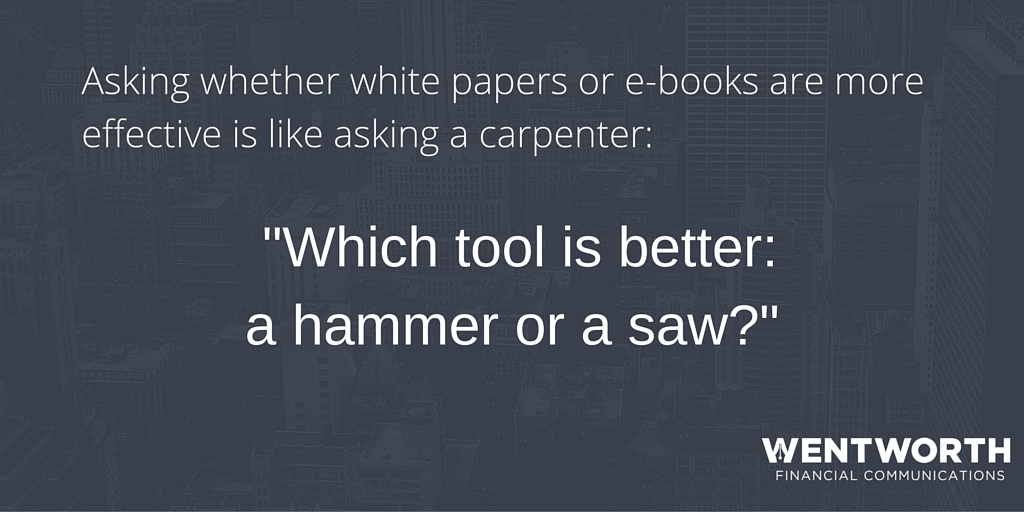
If you work in the financial services or legal industries, you’re undoubtedly very familiar with the term “white paper.” White papers have long been the preferred currency for establishing thought leadership in the professional services world. But lately, a new type of publication—e-books—has burst on the scene as the financial and legal industries have begun embracing content marketing.
The emergence of e-books over the past few years is certainly a positive development, but it has created some confusion. Some people think white papers and e-books are essentially the same thing. (They are not!) Other people think they only need one or the other in their marketing tool kit. (Again, not accurate.) To help clear up this confusion, we examine the similarities and differences of white papers and e-books and explain how to best use each tool to grow your brand.
Defining the Terms
Let’s start by laying out some high-level definitions. Rather than bore you with Merriam-Webster’s not-very-helpful definitions (which you can find here and here if you’ve got time to kill), I’ll explain what these terms mean in the context of content marketing for the asset management, investment banking, wealth management, accounting, private equity, insurance, and legal industries.
- White paper: A report that provides an in-depth look at a fairly technical topic and uses objective data and/or concrete examples to support the report’s hypothesis.
- E-book: An electronic document that is designed to introduce a new concept or answer the reader’s questions about the topic.
What They Look Like
One of the easiest ways to differentiate between white papers and e-books is to start by describing their appearances and formatting.
- White papers are written like articles that you might find in a magazine or journal. The text typically takes up 80% of the page, and the primary visual elements are charts and graphs that are inserted into the text. The text flows seamlessly from one page to the next (although subheads will be used to break up the text). To get the full understanding of the document, the reader needs to read through the text in a linear fashion: starting at the beginning and working his or her way to the end. While length can vary, white papers typically are between four and 12 pages long. They certainly can be longer, but it is extremely hard to hold a reader’s attention much beyond 10 pages. Here are some examples of financial services white papers from Putnam, PwC, and FIS.
- E-books are essentially a hybrid of a white paper and a PowerPoint presentation. Like a white paper, an e-book will use complete sentences and tell a full narrative story. And like a PowerPoint presentation, an e-book will lean heavily on photos, icons, interesting fonts, callout quotes, divider slides, and other visual flourishes to make the story come to life. Often with e-books, each page contains one distinct thought, so the text does not flow from one page to the next. In terms of length, e-books typically range from 10 to 40 pages. To see an example of an e-book, check out one that we published, The Five Things You Need to Create an Investment-Grade Newsletter.
What They Are Good at Communicating
Asking whether white papers or e-books are more effective forms of content marketing for financial services firms is like asking a carpenter: “Which tool is better: a hammer or a saw?” The answer to that question completely depends on what you’re trying to accomplish.
- White papers are more effective when you’re trying to show that you have a unique perspective on a topic that the audience already has a significant amount of familiarity with. Thus, when you’re writing for an audience of fellow advisors or professionals (B2B), white papers are a powerful vehicle for showcasing your expertise. Also, when the logic supporting your main idea requires lengthy explanations that are best illustrated by case studies or data-driven analysis, the narrative structure of a white paper gives you the space to do that. Topics such as “Analyzing Risk in Low-Duration Bond Funds” or “Estate Planning Opportunities in a Rising Interest-Rate Environment” would lend themselves well to white papers.
- E-books are more effective when you are trying to 1) introduce a new idea to your audience, 2) answer fairly fundamental questions that they might have about the topic, or 3) guide the audience through the process of making a decision. Whereas white papers are designed to let you flex your intellectual muscles, e-books are designed to meet the readers at their level of understanding. The visual layout of e-books—more graphics, fewer words per page, one thought per page—allow you to walk the reader through a new idea and show how it relates to his or her needs. E-books are often structured entirely around answering the reader’s questions. Topics such as “Five Ways to Prepare Your Portfolio for Rising Interest Rates,” “How to Maximize Your Medicare Benefits,” or “The Business Owner’s Guide to Succession Planning” would lend themselves to e-books.
Which One Should You Use?
Again, the answer to this question depends entirely on the type of information you are trying to convey and the type of audience you are trying to reach. When thinking about white papers and e-books, it’s not an either/or decision for financial services firms and law firms. It is important to understand the strengths and weaknesses of each format and select the tool that best fits the job.
About the Author
 Scott Wentworth is the founder and head writer of Wentworth Financial Communications, a firm that creates content marketing and thought leadership for financial services firms and law firms. If you ask Scott which type of writing is his favorite, white papers or e-books, he will tell you that it’s like having two children—you love them both equally.
Scott Wentworth is the founder and head writer of Wentworth Financial Communications, a firm that creates content marketing and thought leadership for financial services firms and law firms. If you ask Scott which type of writing is his favorite, white papers or e-books, he will tell you that it’s like having two children—you love them both equally.

